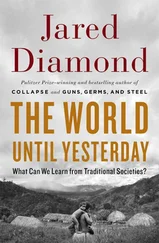Jared Diamond - Guns, Germs & Steel
Здесь есть возможность читать онлайн «Jared Diamond - Guns, Germs & Steel» весь текст электронной книги совершенно бесплатно (целиком полную версию без сокращений). В некоторых случаях можно слушать аудио, скачать через торрент в формате fb2 и присутствует краткое содержание. Жанр: 105. Описание произведения, (предисловие) а так же отзывы посетителей доступны на портале библиотеки ЛибКат.
- Название:Guns, Germs & Steel
- Автор:
- Жанр:
- Год:неизвестен
- ISBN:нет данных
- Рейтинг книги:5 / 5. Голосов: 1
-
Избранное:Добавить в избранное
- Отзывы:
-
Ваша оценка:
- 100
- 1
- 2
- 3
- 4
- 5
Guns, Germs & Steel: краткое содержание, описание и аннотация
Предлагаем к чтению аннотацию, описание, краткое содержание или предисловие (зависит от того, что написал сам автор книги «Guns, Germs & Steel»). Если вы не нашли необходимую информацию о книге — напишите в комментариях, мы постараемся отыскать её.
Guns, Germs & Steel — читать онлайн бесплатно полную книгу (весь текст) целиком
Ниже представлен текст книги, разбитый по страницам. Система сохранения места последней прочитанной страницы, позволяет с удобством читать онлайн бесплатно книгу «Guns, Germs & Steel», без необходимости каждый раз заново искать на чём Вы остановились. Поставьте закладку, и сможете в любой момент перейти на страницу, на которой закончили чтение.
Интервал:
Закладка:
APPLES OR INDIANS • 141
matter for the first farmers to take the seeds of wild cereals growing on hillsides and dependent on unpredictable rains, and to plant those seeds in the damp valley bottoms, where they would grow reliably and be less dependent on rain.
The Fertile Crescent's biological diversity over small distances contributed to a fourth advantage—its wealth in ancestors not only of valuable crops but also of domesticated big mammals. As we shall see, there were few or no wild mammal species suitable for domestication in the other Mediterranean zones of California, Chile, southwestern Australia, and South Africa. In contrast, four species of big mammals—the goat, sheep, pig and cow—were domesticated very early in the Fertile Crescent, possibly earlier than any other animal except the dog anywhere else in the world. Those species remain today four of the world's five most important domesticated mammals (Chapter 9). But their wild ancestors were commonest in slightly different parts of the Fertile Crescent, with the result that the four species were domesticated in different places: sheep possibly in the central part, goats either in the eastern part at higher elevations (the Zagros Mountains of Iran) or in the southwestern part (the Levant), pigs in the north-central part, and cows in the western part, including Anatolia. Nevertheless, even though the areas of abundance of these four wild progenitors thus differed, all four lived in sufficiently close proximity that they were readily transferred after domestication from one part of the Fertile Crescent to another, and the whole region ended up with all four species.
Agriculture was launched in the Fertile Crescent by the early domestication of eight crops, termed "founder crops" (because they founded agriculture in the region and possibly in the world). Those eight founders were the cereals emmer wheat, einkorn wheat, and barley; the pulses lentil, pea, chickpea, and bitter vetch; and the fiber crop flax. Of these eight, only two, flax and barley, range in the wild at all widely outside the Fertile Crescent and Anatolia. Two of the founders had very small ranges in the wild, chickpea being confined to southeastern Turkey and emmer wheat to the Fertile Crescent itself. Thus, agriculture could arise in the Fertile Crescent from domestication of locally available wild plants, without having to wait for the arrival of crops derived from wild plants domesticated elsewhere. Conversely, two of the eight founder crops could not have been domesticated anywhere in the world except in the Fertile Crescent, since they did not occur wild elsewhere.
Thanks to this availability of suitable wild mammals and plants, early peoples of the Fertile Crescent could quickly assemble a potent and bal-
142. " GUNS, GERMS, AND STEEL
anced biological package for intensive food production. That package comprised three cereals, as the main carbohydrate sources; four pulses, with 20-25 percent protein, and four domestic animals, as the main protein sources, supplemented by the generous protein content of wheat; and flax as a source of fiber and oil (termed linseed oil: flax seeds are about 40 percent oil). Eventually, thousands of years after the beginnings of animal domestication and food production, the animals also began to be used for milk, wool, plowing, and transport. Thus, the crops and animals of the Fertile Crescent's first farmers came to meet humanity's basic economic needs: carbohydrate, protein, fat, clothing, traction, and transport.
A final advantage of early food production in the Fertile Crescent is that it may have faced less competition from the hunter-gatherer lifestyle than that in some other areas, including the western Mediterranean. Southwest Asia has few large rivers and only a short coastline, providing relatively meager aquatic resources (in the form of river and coastal fish and shellfish). One of the important mammal species hunted for meat, the gazelle, originally lived in huge herds but was overexploited by the growing human population and reduced to low numbers. Thus, the food production package quickly became superior to the hunter-gatherer package. Sedentary villages based on cereals were already in existence before the rise of food production and predisposed those hunter-gatherers to agriculture and herding. In the Fertile Crescent the transition from hunting-gathering to food production took place relatively fast: as late as 9000 b.c. people still had no crops and domestic animals and were entirely dependent on wild foods, but by 6000 b.c. some societies were almost completely dependent on crops and domestic animals.
The situation in Mesoamerica contrasts strongly: that area provided only two domesticable animals (the turkey and the dog), whose meat yield was far lower than that of cows, sheep, goats, and pigs; and corn, Meso-america's staple grain, was, as I've already explained, difficult to domesticate and perhaps slow to develop. As a result, domestication may not have begun in Mesoamerica until around 3500 b.c. (the date remains very uncertain); those first developments were undertaken by people who were still nomadic hunter-gatherers; and settled villages did not arise there until around 1500 b.c.
inallthis discussion of the Fertile Crescent's advantages for the early rise of food production, we have not had to invoke any supposed advan-
APPLES OR INDIANS • 143
taees of Fertile Crescent peoples themselves. Indeed, I am unaware of anyone's even seriously suggesting any supposed distinctive biological features of the region's peoples that might have contributed to the potency of its food production package. Instead, we have seen that the many distinctive features of the Fertile Crescent's climate, environment, wild plants, and animals together provide a convincing explanation.
Since the food production packages arising indigenously in New Guinea and in the eastern United States were considerably less potent, might the explanation there lie with the peoples of those areas? Before turning to those regions, however, we must consider two related questions arising in regard to any area of the world where food production never developed independently or else resulted in a less potent package. First, do hunter-gatherers and incipient farmers really know well all locally available wild species and their uses, or might they have overlooked potential ancestors of valuable crops? Second, if they do know their local plants and animals, do they exploit that knowledge to domesticate the most useful available species, or do cultural factors keep them from doing so?
As regards the first question, an entire field of science, termed ethnobiol-ogy, studies peoples' knowledge of the wild plants and animals in their environment. Such studies have concentrated especially on the world's few surviving hunting-gathering peoples, and on farming peoples who still depend heavily on wild foods and natural products. The studies generally show that such peoples are walking encyclopedias of natural history, with individual names (in their local language) for as many as a thousand or more plant and animal species, and with detailed knowledge of those species' biological characteristics, distribution, and potential uses. As people become increasingly dependent on domesticated plants and animals, this traditional knowledge gradually loses its value and becomes lost, until one arrives at modern supermarket shoppers who could not distinguish a wild grass from a wild pulse.
Here's a typical example. For the last 33 years, while conducting biological exploration in New Guinea, I have been spending my field time there constantly in the company of New Guineans who still use wild plants and animals extensively. One day, when my companions of the Fore tribe and were starving in the jungle because another tribe was blocking our return to our supply base, a Fore man returned to camp with a large rucksack full of mushrooms he had found, and started to roast them. Dinner at ast! But then I had an unsettling thought: what if the mushrooms were poisonous?
Интервал:
Закладка:
Похожие книги на «Guns, Germs & Steel»
Представляем Вашему вниманию похожие книги на «Guns, Germs & Steel» списком для выбора. Мы отобрали схожую по названию и смыслу литературу в надежде предоставить читателям больше вариантов отыскать новые, интересные, ещё непрочитанные произведения.
Обсуждение, отзывы о книге «Guns, Germs & Steel» и просто собственные мнения читателей. Оставьте ваши комментарии, напишите, что Вы думаете о произведении, его смысле или главных героях. Укажите что конкретно понравилось, а что нет, и почему Вы так считаете.










